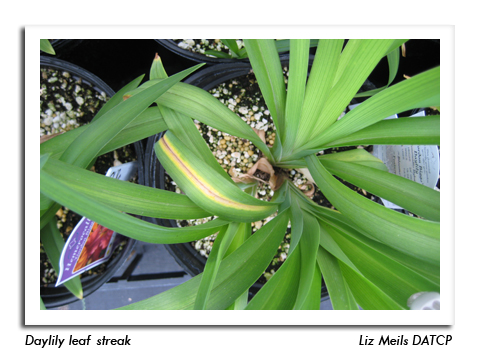
 |
|
|
Nursery & Forest
Volume 60 Number 4 Date 05/14/2015 GYPSY MOTH - Aerial spraying for gypsy moth caterpillars started May 13 with the treatment of 3,300 acres in Crawford, Green, La Crosse, Lafayette, Monroe and Rock counties. During this first phase of the 2015 spray season, planes are applying Bacillus thuringiensis var. kurstaki or Btk, a biological insecticide acceptable for organic use. Most sites will receive a second application 3-7 days after the first one. Twenty-one counties are scheduled to be treated this year. Larvae are predominantly in the first to second instars throughout southern and central Wisconsin. -- Rick Hummell, DATCP Gypsy Moth Program BOTRYTIS BLIGHT - Nursery inspectors observed this gray mold disease of greenhouse floral crops on begonia, geranium and New Guinea impatiens in Kenosha, Racine and Waukesha counties. Symptoms of botrytis appear as brown spots on flower petals and irregularly-shaped necrotic areas on the leaves. The leaf spots develop a grayish mass of fungal spores that disperse on splashing water or wind. Botrytis can develop at any stage and may affect any plant part. Measures that reduce humidity levels below 85% and increase air circulation can help minimize its occurrence. Treatment with an appropriate fungicide or removal from the greenhouse is recommended for symptomatic plants. DAYLILY LEAF STREAK - Several daylily varieties at nurseries visited in the previous week were infected with this fungal disease, characterized by a central, yellow streak along the leaf midvein that starts at the leaf tips and progresses downward. Removing infected leaves as they appear, minimizing overhead watering, and fertilizing plants properly to promote growth of new leaves should help to reduce the spread of this primarily cosmetic daylily disorder. Complete removal of dead leaves each fall is also recommended to eliminate the source of the leaf streak fungus. FIRE BLIGHT - During recent inspections, this destructive bacterial disease was found on 'Bing', 'Black Tartarian', 'Rainier', and 'Sweetheart' cherry trees at nursery retail locations in Kenosha, Racine and Waukesha counties. Symptoms are cankered twigs and branches with blackened, drooping foliage that appear to have been scorched. The pathogenic bacteria multiply on the edge of cankers formed the previous year and are disseminated by insects, wind, and rain splash. Prompt removal of cankered branches or "strikes" 12 inches beyond the diseased area can reduce the problem. Sterilizing tools with a 10% bleach solution between cuts is also recommended. IMPATIENS NECROTIC SPOT VIRUS - This virus disease was confirmed on several tuberous begonia samples collected from a Brown County nursery. INSV is spread primarily by the western flower thrips and propagation of infected plants or cuttings. The virus can infect plants such as amaranthus, aster, calendula, coleus and dahlia, rendering them unsalable. Symptoms vary by host and may present as stunting, necrotic leaf spots, ring spots, streaking or mosaic patterns. Control of thrips populations in greenhouse settings is critical to reducing INSV spread. Carrying over plant material from season to season increases the risk of INSV and should be avoided by nurseries and greenhouses with virus problems. -- Ellen Hermanson, DATCP Nursery Inspector 




|
|
|